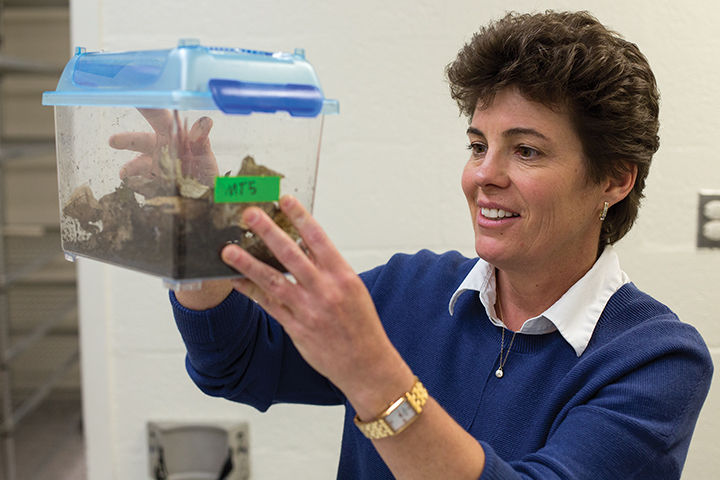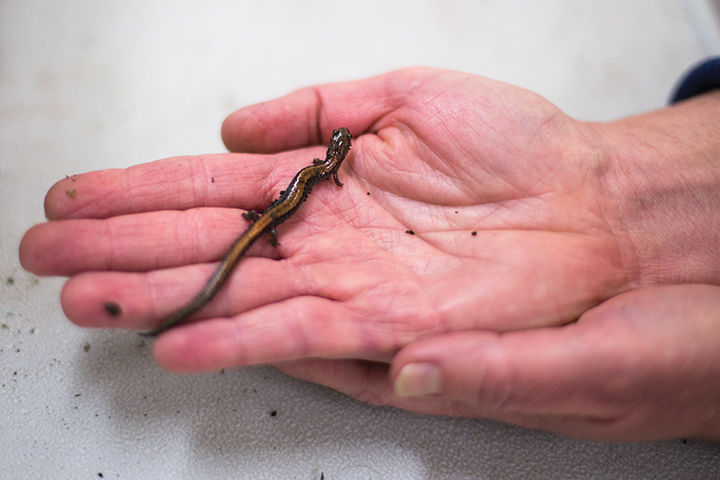University biology professor Karen Lips has amassed thousands of skin swabs collected from salamanders for years, from nearby forests in the Appalachian Mountains and a preserved Smithsonian collection.
While she’s been looking for a link between warmer climates and shrinking salamander populations, these samples have contributed to understanding the global distribution of a newly discovered fungus that is causing many of these creatures to die.
Yesterday, an international team of scientists released a study that surveyed amphibians around the world and found the fungus, scientifically known as Batrachochytrium salamandrivorans, or Bs, is present outside of the U.S. However, it is present in the pet trade, meaning there is a chance it could escape into the wild and cause population declines in our native salamanders, Lips said.
“We’ve sampled more than 1,400 salamanders from the museum, and from the wild, and we shared samples from about 800 of them with our colleagues to test them for Bs,” said Carly Muletz, a university biology doctoral candidate.
These chytrid fungi kill amphibians through a systematic disruption of their skin, which reduces their ability to absorb water or exchange oxygen and carbon dioxide. Many salamanders are lungless, and most amphibians depend on their skin to keep their blood chemistry normal, Lips said.
These fungi upset that balance, causing a form of cardiac arrest that kills the salamander.
“There are no vaccinations to minimize the chances of getting the fungus,” Lips said. “We can give them an antibacterial bath and release them, but they’re going to get it again.”
Although Bs has yet to be seen in the U.S., it is killing salamanders in Europe. The fear is that Bs will spread to the U.S. and cause devastating declines in our native salamanders. The U.S. is a global biodiversity hub for salamanders, with more than 150 species.
The fire salamanders from the Netherlands have lost about 96 percent of their population due to Bs infections, according to the study.
“The pet trade and food trade are places where this [Bs] fungus could enter the U.S.,” Lips said. “We have to be careful that it doesn’t escape from shipment containers and other means of transporting these guys into the country.”
In addition to studying American salamanders, Lips and her lab members also work with chytrid fungus in Central America. Graziella Vittoria DiRenzo, a fourth-year biology doctoral candidate, focused her research efforts on amphibian population dynamics in Panama. DiRenzo is studying the transmission of another fungus — Batrachochytrium dendrobatidis, also known as Bd — in Panama.
“No one really knows about the aquatic fungus, so it could get trapped in the mud, on your boots or even your truck in the tropics,” DiRenzo said.
The invasiveness and transferable properties of this Bs fungus make it comparable to the human influenza virus, Muletz said.
“You really only need one or two infected individuals to go into the water to produce enough of these cells and send them out into the water and to all of the other salamanders,” Muletz said.
Keeping salamanders safe from this fungus is crucial for local populations, Lips said, as 17 percent of all salamanders are located in the Appalachian Mountains region. Salamanders play important roles in the ecosystems of forests, streams and ponds, and loss of that diversity would affect the ecology of the habitats and other animals that live in them.
Although there is no direct way for university students to help stop the deadliness of the fungus, there are ways to prevent it from entering an ecosystem. Never release captive animals into the wild, as pets can be infected with diseases, Lips said.
“If you are walking from stream to stream, you can wash off your boots and stop the transfer of the fungus to the new waterway,” said Alexander Novarro, a university biology doctoral candidate. “You can also wash off fishing equipment when going from waterway to waterway and also stop emptying aquariums into a nearby lake or stream.”
Dr. Karen Lips, a university biology professor, poses with Salamanders in her lab in the Biology-Psychology building. Lips helped in the discovery of a fungus that causes many salamanders to die.
Dr. Karen Lips holds her research subject in her lab in the Biology-Psychology building.





